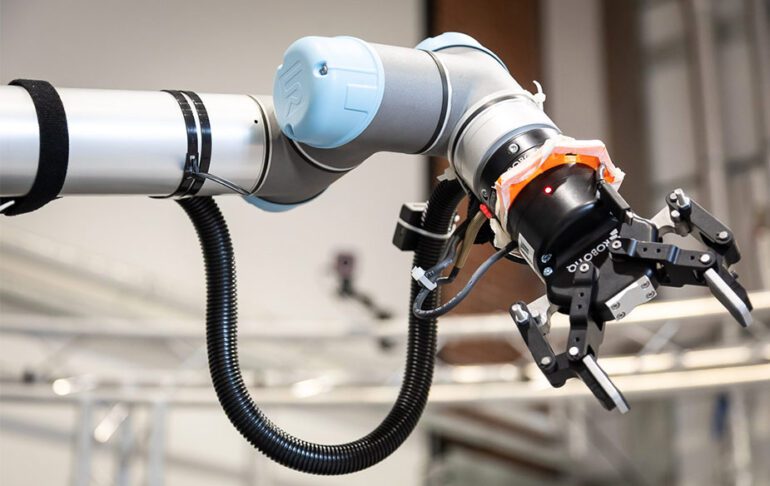TL;DR:
- MIT and UC Berkeley researchers, in collaboration with NYU and UC Berkeley, have introduced a groundbreaking framework.
- The framework enables humans to teach robots household tasks with minimal effort.
- It addresses the challenge of robots struggling with unexpected scenarios or unfamiliar objects.
- An algorithm-based framework generates counterfactual explanations when robots fail, helping identify necessary modifications.
- Human feedback and generated explanations fine-tune the robot’s performance more efficiently.
- The system reduces retraining time and enhances robots’ adaptability in new environments.
- It overcomes the limitations of traditional imitation learning by identifying unimportant visual elements.
- The framework has been validated through simulations, outperforming conventional techniques.
- The researchers aim to implement the framework on actual robots, reducing the time required to generate new data.
- Ultimately, this framework revolutionizes robotics, leading to adaptable robots that seamlessly integrate into daily life, offering valuable assistance and support.
Main AI News:
In a groundbreaking collaboration between MIT, UC Berkeley, New York University, and the University of California at Berkeley, researchers have introduced a cutting-edge framework that empowers humans to effectively teach robots how to perform household tasks with minimal effort. This innovative approach has the potential to significantly enhance the adaptability of robots in new environments, making them invaluable assistants for the elderly and individuals with disabilities across various settings.
One of the key challenges faced by robots is their limited ability to handle unexpected scenarios or unfamiliar objects during their training. As a result, robots often struggle to recognize and perform tasks involving unknown items. Existing training methodologies fail to shed light on the reasons behind these failures, leading to a frustrating and time-consuming retraining process.
The absence of mechanisms to identify failure causes and provide feedback hampers the learning process for robots, as explained by researchers at MIT. To tackle this issue head-on, they have developed an algorithm-based framework that generates counterfactual explanations when a robot fails to complete a task. These explanations offer valuable insights into the necessary modifications required for the robot to succeed.
When faced with a failure, the system generates a set of counterfactual explanations that illustrate the changes needed for the robot to successfully complete the task. These counterfactuals are presented to the human user, who is then asked to provide feedback on the failure. Combining this feedback with the generated explanations, the system creates new data that fine-tunes the robot’s performance.
Fine-tuning involves efficiently tweaking a machine-learning model that has already been trained for one task to perform a similar yet distinct task. Through this approach, the researchers have been able to train robots more efficiently and effectively compared to traditional methods, significantly reducing the amount of time required from the user.
Traditionally, one common way to retrain a robot for a specific task is through imitation learning, where the user demonstrates the desired action. However, this method often results in the robot developing a limited understanding, such as associating a mug with a specific color. The researchers have identified this limitation and devised a solution within their system.
Their system identifies the specific object the user wants the robot to interact with and determines which visual aspects are insignificant to the task at hand. By doing so, it generates synthetic data by altering these “unimportant” visual elements through a process known as data augmentation.
The framework follows a three-step process to ensure effective training:
- Presenting the task that led to the robot’s failure.
- Collecting a demonstration from the user to understand the desired actions.
- Generating counterfactuals by exploring possible modifications to enable the robot’s success.
By incorporating human feedback and generating a multitude of augmented demonstrations, the system fine-tunes the robot’s learning process with remarkable efficiency.
To gauge the effectiveness of their framework, the researchers conducted studies involving human users who were asked to identify elements that could be changed without affecting the task. The results clearly demonstrated that humans excel at this type of counterfactual reasoning, underscoring the effectiveness of this step in bridging human reasoning with robot reasoning.
The researchers further validated their approach through simulations where robots were trained for tasks such as navigating to a goal object, unlocking doors, and placing objects on tabletops. In each case, their method outperformed conventional techniques, enabling robots to learn faster and with fewer user demonstrations.
Looking ahead, the researchers aim to implement their framework on actual robots and continue exploring ways to reduce the time required to create new data using generative machine-learning models. The ultimate goal is to equip robots with human-like abstract thinking, enabling them to better understand tasks and their surroundings.
Conclusion:
The introduction of this groundbreaking framework by MIT and UC Berkeley researchers, in collaboration with NYU and UC Berkeley, has far-reaching implications for the robotics market. The framework’s ability to empower humans to teach robots household tasks with minimal effort opens up new opportunities for the widespread adoption of robotic assistance in diverse settings. By addressing the challenges of unexpected scenarios and unfamiliar objects and by significantly reducing retraining time, this framework enhances the adaptability of robots, making them more capable of assisting the elderly and individuals with disabilities.
Moreover, the system’s ability to fine-tune robot performance through human feedback and counterfactual explanations ensures efficient learning and improved task completion. As a result, the robotics market can anticipate a future where highly adaptable and versatile robots seamlessly integrate into daily life, offering valuable support and assistance in various environments.

